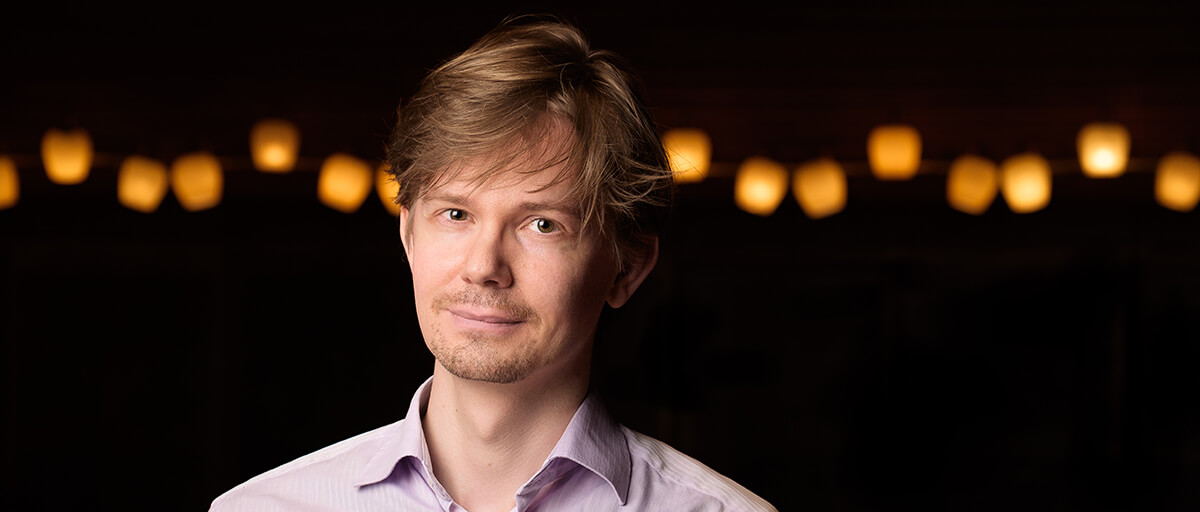Biography
Frederik Magle, Composer, Organist, and Pianist

Frederik Magle’s music has united some of Denmark’s biggest performing groups and celebrated some of the nation’s most significant milestones. As a musician, he has worked across genres and styles, represented his country at international competitions and forged an individual and distinctive path that remains unparalleled in Scandinavia. ‘I write to instill feelings and awaken emotions in the listener,’ he has said; ‘I can’t help but invest myself emotionally in the things I do.’
Born on the island of Falster, Magle was a child prodigy who was 8 when his music performed in public for the first time. He was admitted to the Royal Danish Academy of Music a year early, the only student approved to major in both organ and composition. Grateful but restless, he left after a year and a half, eager to get to work in both capacities. Then as now, his position at an oblique angle to Denmark’s musical establishment gave him ‘a different sort of freedom’ and has sharpened his perception of his audience.
After attending the composer workshop at Lerchenborg, Magle produced his first mature work, the organ symphony Let There Be Light (1993). A clearly argued, densely woven piece uniting elements of the French organ tradition with Magle’s own propensity for structural layering and clear goals, it was released by EMI records. There followed an organ concerto The Infinite Second (1994) and symphony for piano and orchestra commissioned by Denmark’s most well known export, LEGO (LEGO Fantasia, 1996). The same year saw the first performance of Magle’s seasonal cantata A Newborn Child (1996) – a pensive and sometimes dark reflection on the nativity for choir, organ, brass and percussion.
Magle’s relationship with the Denmark’s royal house was initiated with a work written to mark a visit by Queen Margrethe II and Prince Henrik to the composer’s hometown on Falster, Stubbekøbing. There followed music for the christenings of both Prince Nikolai and Prince Felix. The lucid postlude Lys på din vej (‘Light on Your Path’) for organ and brass quintet, written for the former, became the title work for another EMI album.
Magle’s contact with the royal family led to the Cantabile Suite, settings of three poems by Prince Henrik, ‘Souffle le vent’ (2004), ‘Cortège & Danse Macabre’ and ‘Carillon’ (both 2009) for solo voices, chorus, and orchestra. Combining Magle’s trademark thematic clarity, free tonality and strong narrative atmosphere, all three were premiered by the Danish National Symphony Orchestra with vocal soloists conducted by Thomas Dausgaard, on Prince Henrik’s seventieth and seventy-fifth birthdays respectively.
In the gap between the completion of the first song and its successors, Magle grappled with a period of creative block from which he emerged with a fresh impetus and a new sense of direction. Working increasingly as a consultant for organ building projects, he wrote music for the inauguration of new instruments and combined a series of 22 organ improvisations on the album Like a Flame (2010). The major work of the decade that followed, Anastasis Mass (2017) incorporated improvisatory organ interludes with electronic and rock music elements within an all-embracing, boundlessly imaginative neo-gothic take on Christian liturgy. It also furthered the composer’s joyous approach to writing for percussion.
The fusion of Anastasis Mass was not without precedent. In 2011, Magle collaborated with the Danish Hip-Hop group Suspekt on the album Elektra, and had previously explored the space between classical and rock genres in his own work Polyphony [1998]. He has collaborated with the Danish jazz musicians Niels-Henning Ørsted Pedersen, Niels Lan Doky and John Tchicai. More recently he has worked in film, scoring Sami Saif’s documentary Tove i stykker.
In 2020, Magle’s music became the first to be heard live in concert in Denmark after the global Covid-19 pandemic shut down concert-giving activities around the world. His Fanfare for the Royal Danish Orchestra opened a concert given by the ensemble at the Copenhagen Opera House on 7 June 2020, conducted by Thomas Søndergård. A year earlier, Denmark’s biggest hospital, Rigshospitalet, installed a recording of his work The Secret Garden in a specially created space on the radiotherapy ward.
Music by Frederik Magle has been performed by the London Philharmonic, Danish National Symphony, Royal Danish Orchestra, South Jutland Philharmonic, Riga Philharmonic and Zurich Chamber Orchestras among others. He has collaborated and toured with the violinist Nikolaj Szeps-Znaider, who premiered the theme and variations work for violin and piano Journey in Time (1999) at the Concertgebouw in Amsterdam. The notion of music’s ability to play with time adumbrated in that piece will form the basis of major new orchestral still to come.
In 2017, Magle was appointed to his first official organist position, at St Paul’s Church in Copenhagen, where he is employed as both performer (on organ and piano) and composer. He writes music for the church’s liturgical cycle and presents regular improvisations on liturgical tune and themes on both instruments.
– Andrew Mellor, 2020
